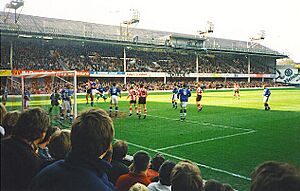The Dell (Southampton) facts for kids

Exterior of the Dell in 2000
|
|
| Location | Milton Road, Southampton, Hampshire, England |
|---|---|
| Coordinates | 50°54′53″N 001°24′47″W / 50.91472°N 1.41306°W |
| Owner | Southampton Leisure Holdings PLC |
| Operator | Southampton F.C. |
| Type | Football stadium |
| Capacity | 15,200 |
| Surface | Grass |
| Construction | |
| Broke ground | 1897 |
| Opened | September 1898 |
| Expanded | 1927, 1929, 1980s, 1990s |
| Closed | May 2001 |
| Demolished | June – 13 July 2001 |
| Construction cost | £7,000 – £9,000 |
| Architect | Archibald Leitch (the West Stand) |
| Tenants | |
| Southampton F.C. (1898–2001) | |
The Dell was a famous football stadium in Southampton, England. It was the home ground for Southampton F.C. for over 100 years, from 1898 until 2001. This historic stadium saw many exciting matches and was a special place for fans.
Contents
Finding a New Home for Southampton F.C.
Before the Dell, Southampton F.C. played at the County Ground. They rented this space from the local cricket club. The rent was quite expensive for the football club. Because of this, the team started looking for their own permanent home.
In 1897, the club found a promising piece of land. It was a narrow valley, or "dell," not far from their old ground. This natural valley had sloping sides, which would be perfect for building stands for spectators.
Building the Dell Stadium
A local fish merchant named George Thomas bought the land. He saw its potential for a football stadium. He spent a lot of money, between £7,500 and £9,000, to get the site ready. This included draining the land and leveling the playing field.
The valley had a stream running through it, which was channeled into a pipe. The ground was then made flat and covered with grass. When it was finished, the stadium could hold about 24,500 people. There were standing areas and covered stands with seats. At first, the stadium didn't have an official name. People just started calling it "the Dell."
Exciting Early Days
The Dell officially opened in September 1898. The very first game was against Brighton United. Southampton won 4–1, with Watty Keay scoring the first goal.
In 1901, the Dell even hosted an international match. The England team played against Ireland and won 3–0.
Making the Stadium Better
Over the years, the Dell was updated several times. In 1927, the original West Stand was taken down. A new, improved West Stand was built in its place. This was designed by Archibald Leitch, a famous architect who designed many football stadiums.
A year later, a fire accidentally destroyed the East Stand. A new stand was quickly built, making the stadium even bigger. It could then hold around 30,000 fans.
Challenges During Wartime
During World War II, the Dell faced some tough times. In November 1940, a German bomb hit the stadium. It left a huge hole in the pitch! Southampton F.C. had to play their games away from home while the pitch was fixed.
Later, in March 1941, an explosion caused a big fire in the West Stand. Luckily, it was rebuilt soon after. The Dell reopened in October 1941.
Post-War Football and Floodlights
After the war, the Dell made history. In 1950, it became the first stadium in England to have permanent floodlights. This meant games could be played at night! The first game under these lights was a friendly match in October 1950.
Huge crowds came to watch games at the Dell. In 1969, a record 31,044 fans watched Southampton play Manchester United. The stadium hosted top-level football for most of its later years. Southampton F.C. even won the FA Cup in 1976!
Modern Changes to the Dell
In the 1980s and 1990s, more changes happened. New stands were built at the ends of the stadium. After a sad event called the Hillsborough disaster in 1989, new rules meant all top football stadiums had to have seats for everyone. The Dell became an all-seater stadium.
By the 1993–94 season, the Dell could hold just over 15,000 people. This made it the smallest stadium in England's top football league.
The Final Chapter of the Dell
Because the Dell was getting too small, Southampton F.C. started looking for a new home. They found a spot on the banks of the River Itchen. Plans were made for a brand new, much larger stadium with 32,000 seats. This new stadium would be called St Mary's Stadium.
The new stadium was ready for the 2001–02 football season. On May 19, 2001, a special moment happened. Matt Le Tissier, a legendary player for Southampton, scored the last competitive goal at the Dell. He scored a fantastic goal in the final league game, helping Southampton win 3–2 against Arsenal.
A week later, fans said goodbye to the Dell. They even took home seats and pieces of the pitch as souvenirs! The very last goal at the Dell was scored by Uwe Rösler in a friendly match.
The Dell was taken down in July 2001. Today, a housing estate stands where the stadium once was. The apartment buildings are named after famous Southampton players, like Stokes Court and Le Tissier Court. There's even a green space where the center of the pitch used to be.



